Elizabeth II
| Elizabeth II | |||||||||||||||||||||||||||||||||||||||||||||||||||||||||||||||
|---|---|---|---|---|---|---|---|---|---|---|---|---|---|---|---|---|---|---|---|---|---|---|---|---|---|---|---|---|---|---|---|---|---|---|---|---|---|---|---|---|---|---|---|---|---|---|---|---|---|---|---|---|---|---|---|---|---|---|---|---|---|---|---|
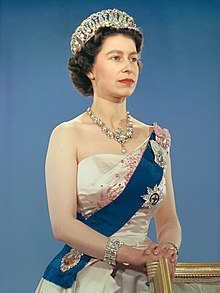 Portrait of Elizabeth II, 1959 | |||||||||||||||||||||||||||||||||||||||||||||||||||||||||||||||
Queen of the United Kingdom and the other Commonwealth realms
| |||||||||||||||||||||||||||||||||||||||||||||||||||||||||||||||
| Reign | 6 February 1952 – 8 September 2022 | ||||||||||||||||||||||||||||||||||||||||||||||||||||||||||||||
| Coronation | 2 June 1953 | ||||||||||||||||||||||||||||||||||||||||||||||||||||||||||||||
| Predecessor | George VI | ||||||||||||||||||||||||||||||||||||||||||||||||||||||||||||||
| Successor | Charles III | ||||||||||||||||||||||||||||||||||||||||||||||||||||||||||||||
| Born | Princess Elizabeth of York 21 April 1926 17 Bruton street, Mayfair, London, England | ||||||||||||||||||||||||||||||||||||||||||||||||||||||||||||||
| Died | 8 September 2022 (aged 96) Balmoral Castle, Aberdeenshire, Scotland | ||||||||||||||||||||||||||||||||||||||||||||||||||||||||||||||
| Burial | 19 September 2022 King George VI Memorial Chapel, St George's Chapel, Windsor Castle | ||||||||||||||||||||||||||||||||||||||||||||||||||||||||||||||
| Spouse | |||||||||||||||||||||||||||||||||||||||||||||||||||||||||||||||
| Issue Detail | |||||||||||||||||||||||||||||||||||||||||||||||||||||||||||||||
| |||||||||||||||||||||||||||||||||||||||||||||||||||||||||||||||
| House | Windsor Castle | ||||||||||||||||||||||||||||||||||||||||||||||||||||||||||||||
| Father | George VI | ||||||||||||||||||||||||||||||||||||||||||||||||||||||||||||||
| Mother | Elizabeth Bowes-Lyon | ||||||||||||||||||||||||||||||||||||||||||||||||||||||||||||||
Elizabeth II (Elizabeth Alexandra Mary; 21 April 1926 – 8 September 2022) was Head of the Commonwealth and the Queen of the United Kingdom and the other Commonwealth realms from 1952 until her death in 2022.[1]
Elizabeth became queen when her father, King George VI, died on 6 February 1952. At the time of her death, she had ruled longer than any other king or queen in the history of the United Kingdom.[2] She had also ruled longer than any other living king or queen in the world, since the death of Thailand's Bhumibol Adulyadej on 13 October 2016. She was the second-longest reigning monarch in history.
In 1947, Elizabeth married Prince Philip, Duke of Edinburgh, who died in 2021. Elizabeth and Philip had four children, eight grandchildren and 12 great-grandchildren. She died on 8 September 2022 at the age of 96, and was succeeded by her eldest son, Charles III.[3][4]
Early life
[change | change source]Elizabeth was born in her grandparents' home at 17 Bruton street, Mayfair, London on 21 April 1926. Her father was Prince Albert, Duke of York, who later became George VI. Her mother was Elizabeth, Duchess of York.
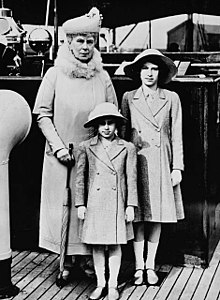
Elizabeth was the granddaughter of King George V and Queen Mary. She was named after her mother. Her nickname was "Lilibet".
Elizabeth had one sister, Princess Margaret. Margaret was born in 1930. The two young princesses were taught at home. They had a governess named Marion Crawford.
Elizabeth was third in the line of succession to the British Throne. The first in line was her uncle, the Prince of Wales. The second in line was her father, the Duke of York.
Elizabeth's grandfather, King George V, died in 1936. Her uncle became King Edward VIII. He was king only for a short time. He abdicated.
His brother, Elizabeth's father the Duke of York, became King George VI.
Elizabeth was 13 years old when World War II started. London was bombed. Elizabeth and Margaret were moved to Windsor Castle. This was for their safety. People thought that they should be sent to Canada. Their mother did not approve this idea.
Elizabeth joined the British army in 1945. She trained to drive trucks. She trained as a mechanic. In 1947, she made her first official trip outside Britain. She went with her parents to South Africa. She made a speech on her 22nd birthday. She said her whole life would be devoted to the service of British Commonwealth and Empire.[5]
Succession
[change | change source]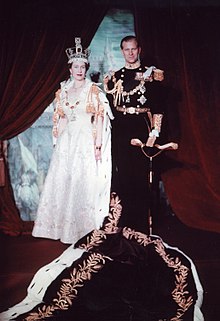
In 1951, the King's health was poor. He could not go to many public events. Princess Elizabeth started to make official visits for him. The King died on 6 February 1952.[6] Elizabeth was crowned Queen on 2 June 1953. The ceremony was held in Westminster Abbey. She wore a dress that was decorated with the national flowers of the countries of the Commonwealth.[7] Many people bought TV sets to watch the event.
Reign
[change | change source]In 1952, the Queen and Prince Philip moved into Buckingham Palace in central London. This is the main official home of the monarch. Her coronation took place in 1953.
Her early years as Queen were spent traveling to many places. In 1953, the Queen and Prince Philip began an around the world tour in the Royal Yacht, Britannia. Their tour went for six months. She was the first reigning monarch to visit Australia, New Zealand and Fiji.
In October 1957, she made an official visit to the United States. She spoke to the United Nations General Assembly. She toured Canada. She became the first monarch to open the nation's Parliament. The Queen liked going to Canada. She called Canada her "home away from home".[8][9]
In February 1961, she visited India, Iran, Pakistan and Nepal for the first time. Since then, the Queen made visits to most Commonwealth countries. She had also been to most European countries and many countries outside Europe.[10]
In 1966, the Aberfan disaster, which was a collapse of a colliery spoil tip onto the village of Aberfan in Glamorgan, Wales. It killed 144 people, most of whom were children. She decided not to visit the village in the aftermath because she thought her presence would take attention away from finding survivors. It was argued that her visit would calm the chaos. Elizabeth visited 8 days later. It is said that not going to Aberfan straight away is her biggest regret.[11]
In 1991, she became the first British monarch to speak to a joint session of the United States Congress. She goes to the Commonwealth Heads of Government Meetings. She is the most widely travelled head of state in history.[10][12]
Some people in Australia wanted a republic, with an elected or appointed president as Head of State instead of the Queen. In 1999, the people of Australia were asked in a referendum whether they wanted a republic. The decision of the people was to remain a monarchy. The Queen visited Australia the following year and said that she would continue to serve Australians as she had done for 48 years.
In 1997, Prince Charles' ex-wife Lady Diana Spencer died in a car crash. The royal family went through a period of criticism from the media and public because the divorce had been very controversial.

In the late 1990s, there were "referendums" in which the people of Scotland and Wales were asked if they wanted parliaments that were separate from the parliament of the United Kingdom. This was called a "devolution policy". As a result, the new Scottish Parliament and the National Assembly of Wales, were set up. The Queen opened the first sessions of these two bodies.
In May 2007, the Queen and Prince Philip made a state visit to the United States, in honour of the 400th anniversary of the Jamestown settlement.
On September 6 2022, two days before her death, the Queen met the new Prime Minister Liz Truss and gave her permission to start her government. This was the Queen's last official act before her death.
Changes to the Commonwealth
[change | change source]
When Elizabeth became Queen on 6 February 1952, she was officially Queen of the United Kingdom, Canada, Australia, New Zealand, South Africa, Pakistan and Ceylon (now called Sri Lanka). These were the Commonwealth countries. She was also Queen of the Union of South Africa (which became a republic in 1961).
There were many more countries that she also ruled, because they belonged to the British Empire. One by one, many of the countries became independent, and as they gained independence she remained Queen of many of them. Altogether, she was sovereign of 32 nations.
Some of the countries she was once Queen of are now republics and have a president as "Head of State". Some of them kept the Queen as "Head of State". Queen Elizabeth II was the only monarch of more than one independent nation. The old British Empire became the Commonwealth of Nations.
It includes both monarchies and republics. It is now called "The Commonwealth". The Queen is the Head of the Commonwealth. She worked hard to keep peace and good communication between all the nations that are members. At the time of her death, Queen Elizabeth II was head of state of fifteen countries including the UK.
Relations with governments and other countries
[change | change source]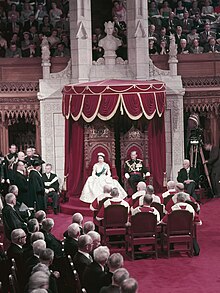
Elizabeth II was friends with many world leaders. Her first Prime Minister of Australia, Sir Robert Menzies called her "My Dear" and recited a poem that said "I will love her till I die". She has friendships with Mary Robinson, President of Ireland (1990–1997) and George W. Bush, who was the first American President in more than 80 years to stay at Buckingham Palace. Nelson Mandela, in a BBC documentary, called her "my friend, Elizabeth".
Ever since she became queen, Elizabeth spent about three hours every day "doing the boxes". The "boxes" are two large red boxes that were brought to her from the Parliament every day. They are full of state papers sent to her from her various departments, embassies, and government offices.[13] One of the most famous photos taken of Elizabeth as a teenager shows her with her father, the King, learning about "the boxes". Because she had been doing this since 1952, she knew a great deal about the government of the UK.
Death and funeral
[change | change source]On 8 September 2022, Buckingham Palace said that the Queen was under medical supervision at Balmoral after doctors said that they were concerned by her health. The statement read, "Following further evaluation this morning, the Queen's doctors are concerned for Her Majesty's health and have recommended she remain under medical supervision. The Queen remains comfortable and at Balmoral."[14][15] The Queen's four children, along with Prince William, Prince Harry, and Camilla, Duchess of Cornwall, travelled to be with her.[16][17] Her death was announced in the evening of the same day.[3]

Her state funeral was on 19 September.[18]
Her daughter Princess Anne registered the death certificate of Elizabeth II. It said she died at 8 September 2022 at 15:10 BST at Balmoral Castle. It also said she died of old age including osteoporosis
It was well known that Elizabeth never planned to abdicate, though she took on fewer public engagements as she grew older and Prince Charles took on more of her duties. On September 8, 2022, Queen Elizabeth died at Balmoral Castle. Prince Charles succeeded her as the monarch.
Personal life
[change | change source]
Princess Elizabeth married Prince Philip, Duke of Edinburgh on 20 November 1947. The wedding was held in Westminster Abbey. The couple lived mostly at Clarence House in London.
The couple had four children. Charles was born on 14 November 1948. Their second child, Anne, was born on 15 August 1950. Their son Andrew was born on 19 February 1960. Their son Edward was born on 10 March 1964. The princes and princess sometimes use the name Mountbatten-Windsor. This is their official last name when they need one (royal families rarely use them).[19]
Prince Philip died on 9 April 2021 at Windsor Castle, aged 99.
In February 2022, Elizabeth II tested positive for COVID-19 after having cold-like symptoms.[20]
Faith and duty
[change | change source]Elizabeth II, as the Monarch of the United Kingdom, was the "Supreme Governor" of the Church of England and sworn protector of the Church of Scotland. She was very interested in the Church of England, but the Archbishop of Canterbury runs the church. She rarely attended the yearly meeting of the General Assembly of the Church of Scotland.
The Queen was deeply religious. In her Christmas Day television broadcast in 2000, she said:
| “ | To many of us, our beliefs are of fundamental importance. For me, the teachings of Christ, and my own personal accountability before God provide a framework in which I try to lead my life. I, like so many of you, have drawn great comfort in difficult times from Christ's words and example.[21] | ” |
The Queen regularly went to church wherever she was: at St. George's Chapel at Windsor Castle, St. Mary Magdalene Church at Sandringham House, Crathie Kirk at Balmoral Castle, and Canongate Kirk in Edinburgh, when she stayed there in Holyroodhouse, her official home in Scotland.
The Queen often met with leaders from other religions as well. In 1980, she became the first British Monarch to visit the Vatican, where she was welcomed by Pope John Paul II. She made another visit 20 years later on 17 October 2000.[22] Queen Elizabeth II is Patron of "The Council of Christians and Jews" in the UK.[23]
The Queen showed a very strong sense of duty, ever since she was a girl. Her father, King George VI, was not meant to be king. Her uncle became king when her grandfather died. But he fell in love with an American woman who was divorced, and that wasn't allowed. So he had to give up being king very shortly after ascending. George VI didn't want to be king, because he was quite nervous and had a stammer. However, Elizabeth's grandfather said that he didn't think her uncle was very good as a king, and wanted George to reign, then Elizabeth. From the moment she realised that one day she would be Queen, she became very interested in her duties and did all she could to help her father. Her promise to serve her people all her life had always been very important to her. Some people thought that, when she was old, perhaps she would retire ("abdicate") and let her son Prince Charles take over. People who knew her well, including Prince Charles, said that this would never happen.[24]
When the Queen was in London, she met her Prime Minister once a week, to talk about events. She also had meetings with the First Minister of Scotland and other Ministers of the Parliament of the United Kingdom, and the Prime Ministers and Ministers of other countries, when she was in their country, or when they visited London.
Courage
[change | change source]
The Queen has often shown courage, ever since she joined the military at 18. During a trip to Ghana in 1961, she was warned that it was dangerous to be near the President Kwame Nkrumah because people wanted to kill him. But she refused to stay away. The Prime Minister of the United Kingdom, Harold Macmillan, wrote that the Queen got very impatient with people if they tried to treat her like "a film star".
In 1964, when the Queen was invited to Quebec, there were fears for her safety because there was opposition to her visit. There were suggestions that the tour should be cancelled. But the Queen's secretary said that the Queen would not want to be stopped from going to Quebec because of any danger.[25] During the Trooping the Colour in 1981, she was shot at, but she carried on. The Queen was praised for her courage and for her ability to keep her horse calm. It was later discovered that the shots were blanks. In 1982, a man called Michael Fagan broke into Buckingham Palace in the morning, and found the Queen's bedroom. He woke her up, and sat on her bed, until the guards came to take him away.
Family relations
[change | change source]Throughout her long reign, Queen Elizabeth II was supported in her duties by her husband, Prince Philip, Duke of Edinburgh. Prince Philip promised to help the Queen on the day of her Coronation. The Queen was also helped by her mother Queen Elizabeth, known as "The Queen Mother", who lived to be 101 years old, and stayed very active in her old-age. The Queen was the patron of many organisations and charities. She had many invitations and official duties. Many of the duties were shared by other members of the Royal Family, who also became become patrons of many organisations.

The Queen was sad about the broken marriages and divorces of three of her children, Prince Charles, Princess Anne and Prince Andrew. Prince Charles's marriage to Lady Diana Spencer was thought to be a fairytale wedding because Diana was young and beautiful, and they seemed very happy. But soon the marriage became troubled, and after their divorce, she was killed in a car accident in 1997. On 9 April 2005, Prince Charles married Camilla Parker-Bowles, whom he had loved for many years. In 2002, within seven weeks of each other, the Queen's mother and sister, Princess Margaret, both died on 30 March and 9 February respectively.
Toward the end of her life, she left more duties to the younger members of the Royal Family, particularly to Prince Charles, who became King when she died.
Wealth
[change | change source]The Queen's wealth was private. It was difficult to estimate how much she was worth. She owned Sandringham House, Balmoral Castle, and other large properties. She did not own Buckingham Palace, Windsor Castle, or the royal collection of art. These are worth millions of pounds. In 2021, Forbes magazine estimated her personal fortune at about US$500 million (£300 million).[26][27]
Jubilees
[change | change source]Silver Jubilee
[change | change source]In 1977, the Queen celebrated her Silver Jubilee. This jubilee marked the 25th anniversary of her coming to the throne.[28] There was a royal procession in the golden State Coach. A service of thanksgiving was held at St. Paul's Cathedral. Millions of people watched on television. There were parties across the UK. Five commemorative stamps were printed in honour of the event. The Jubilee line of the London Underground opened in 1979, named after the anniversary.
Golden Jubilee
[change | change source]In 2002, Elizabeth II celebrated Golden Jubilee. This jubilee marked the 50th anniversary of her coming to the throne.[29] She toured the Commonwealth countries. There was a pop concert in the gardens of Buckingham Palace. A service of thanksgiving was held at St. Paul's Cathedral.
Diamond wedding anniversary
[change | change source]The Queen and Prince Philip celebrated their sixtieth (diamond) wedding anniversary on 19 November 2007, with a special service at Westminster Abbey. The night before, Prince Charles gave a private dinner party at Clarence House for 20 members of the Royal Family.
On the following day, 20 November, the Queen and Prince Philip went on a visit to Malta, where they had stayed from 1949 to 1951 after getting married. A Royal Navy ship, which was nearby, got its sailors to line up on deck to form a big number '60' for the couple.
Diamond Jubilee
[change | change source]In 2012, the Queen's 60 years as monarch were marked by Diamond Jubilee celebrations, including a grand pageant of boats on the Thames[30] and a service of thanksgiving at St Paul's Cathedral.[31]
Sapphire Jubilee and Platinum Wedding Anniversary
[change | change source]In 2017, the Sapphire Jubilee marked the Queen's 65 years as monarch. She was the first British monarch to have a Sapphire Jubilee. Instead of large celebrations, as usual, the Queen spent the day in "quiet reflection" because the day was also the anniversary of her father's death. Commemorative stamps and coins were made in honour of the Jubilee, and a portrait of the Queen wearing sapphire jewellery was reissued.[32]
Also in 2017, the Queen and Prince Philip celebrated their seventieth (Platinum) wedding anniversary. They held a private celebration at Windsor Castle. Westminster Abbey, where they were married, held a three-hour bell ceremony.[33]
Platinum Jubilee
[change | change source]The Queen's Platinum Jubilee was held in February 2022, meaning she has been Queen for 70 years.[34] She would have surpassed Louis XIV of France as the longest-reigning monarch of a sovereign state in world history if she remained Queen until 27 May 2024.[35]
Public opinion
[change | change source]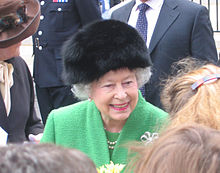
Queen Elizabeth II was very popular in the United Kingdom, her Commonwealth Realms and even in foreign countries. This was partly because of the many small gestures that the Queen did that made people like her, such as her voluntarily paying he taxes even though she didn't legally have to. The Queen was often seen as a voice of reason during troubling times for the country.
During major controversies such as the death of Diana, Princess of Wales, the Prince Andrew and Jeffrey Epstein scandal and also the departure of Harry and Meghan from the royal family, the Queen and the rest of the royal family came under a lot of criticism. However, the Queen still remained a very popular figure.
In 2020, Elizabeth's grandson Prince Harry and his wife Meghan Markle decided to leave the royal family. In several interviews, the couple talked about how being involved with the royal family took a toll on their mental health. This prompted a lot of criticism from media and the public towards the royal family.
In early 2021, Prince Philip died. Due to COVID-19 restrictions, the Queen had to sit alone at his funeral, leading to a lot of sympathy from the public.
The Queen had been credited with keeping the monarchy popular in the UK and the other Commonwealth realms.
Titles and styles
[change | change source]When someone is talking about the Queen, she is called "The Queen" or "Her Majesty". When someone was talking to her, she was called "Your Majesty". After the first time, the person talking to the Queen could say "Ma'am". It is pronounced "Marm". These are the titles that she had:
- 21 April 1925 – 11 December 1936: Her Royal Highness Princess Elizabeth of York
- 11 December 1936 – 20 November 1947: Her Royal Highness The Princess Elizabeth
- 20 November 1947 – 6 February 1952: Her Royal Highness The Princess Elizabeth, The Duchess of Edinburgh
- 6 February 1952 – 8 September 2022: Her Majesty The Queen of the United Kingdom


The Queen had several coats of arms. In the UK, they are known as the "Royal coat of arms of the United Kingdom". Every British monarch has used these arms since the reign of Queen Victoria. The coats of arms used in Scotland and Canada are different to the arms used in England and Wales.
By the end of her reign, Elizabeth II was:
- Queen of Antigua and Barbuda
- Queen of Australia
- Queen of The Bahamas
- Queen of Belize
- Queen of Canada
- Queen of Grenada
- Queen of Jamaica
- Queen of New Zealand
- Queen of Papua New Guinea
- Queen of Saint Kitts and Nevis
- Queen of Saint Lucia
- Queen of Saint Vincent and the Grenadines
- Queen of Solomon Islands
- Queen of Tuvalu
- Queen of the United Kingdom of Great Britain and Northern Ireland
Children
[change | change source]| Name | Birth | Marriage | Divorce | Issue | |
|---|---|---|---|---|---|
| King Charles III (formerly Prince of Wales) | 14 November 1948 | 29 July 1981 | Lady Diana Spencer | 28 August 1996 | Prince William, Prince of Wales Prince Harry, Duke of Sussex |
| 9 April 2005 | Camilla Parker Bowles | ||||
| Princess Anne, Princess Royal | 15 August 1950 | 14 November 1973 | Captain Mark Phillips | 28 April 1992 | Peter Phillips Zara Tindall |
| 12 December 1992 | Timothy Laurence | ||||
| Prince Andrew, Duke of York | 19 February 1960 | 23 July 1986 | Sarah Ferguson | 30 May 1996 | Princess Beatrice of York Princess Eugenie of York |
| Prince Edward, Earl of Wessex | 10 March 1964 | 19 June 1999 | Sophie Rhys-Jones | Lady Louise Windsor James, Viscount Severn | |
Ancestors
[change | change source]Related pages
[change | change source]- Death of Elizabeth II - Article about her death
- Charles III - Her son, the current king
References
[change | change source]- ↑ 13 UK Overseas Territories and three Crown Dependencies. She is also the monarch of 15 other countries: Canada, Australia, New Zealand, Jamaica, Barbados, the Bahamas, Grenada, Papua New Guinea, the Solomon Islands, Tuvalu, Saint Lucia, Saint Vincent and the Grenadines, Antigua and Barbuda, Belize, and Saint Kitts and Nevis.
- ↑ "Elizabeth Set To Beat Victoria's Record As Longest Reigning Monarch In British History". The Huffington Post. 6 September 2014. Retrieved 28 September 2014.
- ↑ 3.0 3.1 "Queen Elizabeth II has died, Buckingham Palace announces". BBC News. 2022-09-08. Retrieved 2022-09-08.
- ↑ "The moment Queen's death was announced". BBC News. Retrieved 2022-09-08.
- ↑ "Historic speeches: 21st birthday speech". British Monarchy Official Website. Archived from the original on 2005-10-01. Retrieved 2007-09-09.
{{cite web}}: CS1 maint: bot: original URL status unknown (link) - ↑ Lacey, Robert; Comp, Robert Lacey (1977). Majesty: Elizabeth II and the House of Windsor. New York : Harcourt Brace Jovanovich. p. 150. ISBN 978-0-15-155684-7.
- ↑ Cotton, Belinda; Ramsey, Ron. "By Appointment: Norman Hartnell's sample for the Coronation dress of Queen Elizabeth II". National Gallery of Australia. Archived from the original on 30 May 2012. Retrieved 12 February 2010.
- ↑ "Elizabeth II, Queen of Canada". Canadian Royal Heritage Trust. Archived from the original on 3 February 2007. Retrieved 6 March 2007.
- ↑ "1964 Quebec visit – speech". CBC. Archived from the original on 2003-07-25.
- ↑ 10.0 10.1 Challands, Sarah (25 April 2006). "Queen Elizabeth II celebrates her 80th birthday". CTV Television Network News. Archived from the original on 30 May 2012. Retrieved 13 June 2007.
- ↑ Forsey, Zoe (2020-07-24). "Queen's 'biggest regret' from her reign - and she still thinks about tragic day". mirror. Retrieved 2023-09-20.
- ↑ "The Real Queen". 1 January 2002.
{{cite episode}}: Missing or empty|series=(help) - ↑ Information supplied by the Royal Household to a parliamentary inquiry into the workings of the monarchy in the early 1970s.
- ↑ "Queen's doctors concerned for her health - palace". BBC News. 8 September 2022. Retrieved 8 September 2022.
- ↑ Davies, Caroline (8 September 2022). "Queen under medical supervision at Balmoral after doctors' concerns". The Guardian. Retrieved 8 September 2022.
- ↑ "Queen under medical supervision as doctors are concerned for her health. Prince Charles, Camilla and Prince William are currently travelling to Balmoral, Clarence House and Kensington Palace said". Sky News. 8 September 2022. Retrieved 8 September 2022.
- ↑ Shaw, Neil (8 September 2022). "Duke of York, Princess Anne and Prince Edward all called to Queen's side". Plymouth Live. Retrieved 8 September 2022.
- ↑ "Funeral for Queen Elizabeth II to be held September 19". CNN. Retrieved September 10, 2022.
- ↑ Prince of Wales's press office.
- ↑ Lee, Dulcie; Durbin, Adam (20 February 2022). "The Queen tests positive for Covid". BBC News. BBC News. BBC News. Retrieved 20 February 2022.
- ↑ Elizabeth II (25 December 2000). "Historic speeches: Christmas Broadcast 2000". British Monarchy Official Website. Archived from the original on 24 December 2005. Retrieved 9 September 2007.
{{cite web}}: CS1 maint: bot: original URL status unknown (link) - ↑ On this Day, 17 October 1980
- ↑ "Presidents, Vice Presidents and Board". Council of Christians and Jews. Archived from the original on 9 July 2009. Retrieved 9 September 2007.
- ↑ "Queen 'will do her job for life'". BBC News. 19 April 2006. Retrieved 4 February 2007.
- ↑ "Courage of the Queen". Canadian Royal Heritage Trust. Archived from the original on 9 September 2007. Retrieved 24 July 2007.
- ↑ "Richest Royals". Forbes. Archived from the original on 2012-11-03.
- ↑ Shapiro, Ariel. "Inside 'The Firm': How The Royal Family's $28 Billion Money Machine Really Works". Forbes. Retrieved 2022-09-08.
- ↑ "Queen celebrates Silver Jubilee". BBC News: On This Day.
- ↑ "In Depth: The Golden Jubilee". BBC News.
- ↑ Thames Diamond Jubilee Pageant, Key facts Archived 2012-06-05 at the Wayback Machine; retrieved 2012-6-3.
- ↑ Raynor, Gordon. "Diamond Jubilee: Duke and Duchess of Cambridge given key role in service at St Paul's," The Telegraph, 29 May 2012; retrieved 2012-6-3.
- ↑ "Gun salutes for Queen's Sapphire Jubilee". BBC News. 2017-02-06. Retrieved 2017-12-06.
- ↑ Association, Press (2017-11-20). "Queen and Prince Philip portraits released to mark 70th anniversary". The Guardian. ISSN 0261-3077. Retrieved 2017-12-06.
- ↑ Queen's Platinum Jubilee to include extra bank holiday, BBC, 12 November 2020
- ↑ Elledge, Jonn (9 September 2015), "Queen Elizabeth II is about to become Britain's longest reigning monarch, so here are some charts", New Statesman, retrieved 16 January 2021
Notes
[change | change source]Further reading
[change | change source]- Bond, Jennie (2002). Elizabeth: Fifty Glorious Years. Readers Digest. ISBN 978-0-7621-0369-0.
- Erickson, Carolly (2004). Lilibet: An Intimate Portrait of Elizabeth II. Macmillan. ISBN 978-0-312-28734-4.
- Pimlott, Ben (2002). The Queen: Elizabeth II and the Monarchy.
- Waller, Maureen (2007). Sovereign Ladies: Sex, Sacrifice, and Power--The Six Reigning Queens of England. Macmillan. ISBN 978-0-312-33801-5.
Other websites
[change | change source]- 1926 births
- 2022 deaths
- English Anglicans
- House of Windsor
- Kings and Queens of the United Kingdom
- Order of Merit of the Federal Republic of Germany
- Recipients of the Decoration for Services to the Republic of Austria
- Recipients of the Order of the Legion of Honour
- Grand Crosses of the Order of the Legion of Honour
- Recipients of the Nishan-e-Pakistan
- Recipients of the Order of the Aztec Eagle
- Royalty from London
- Time People of the Year
- Elizabeth II
- Heirs and heiresses presumptive

